
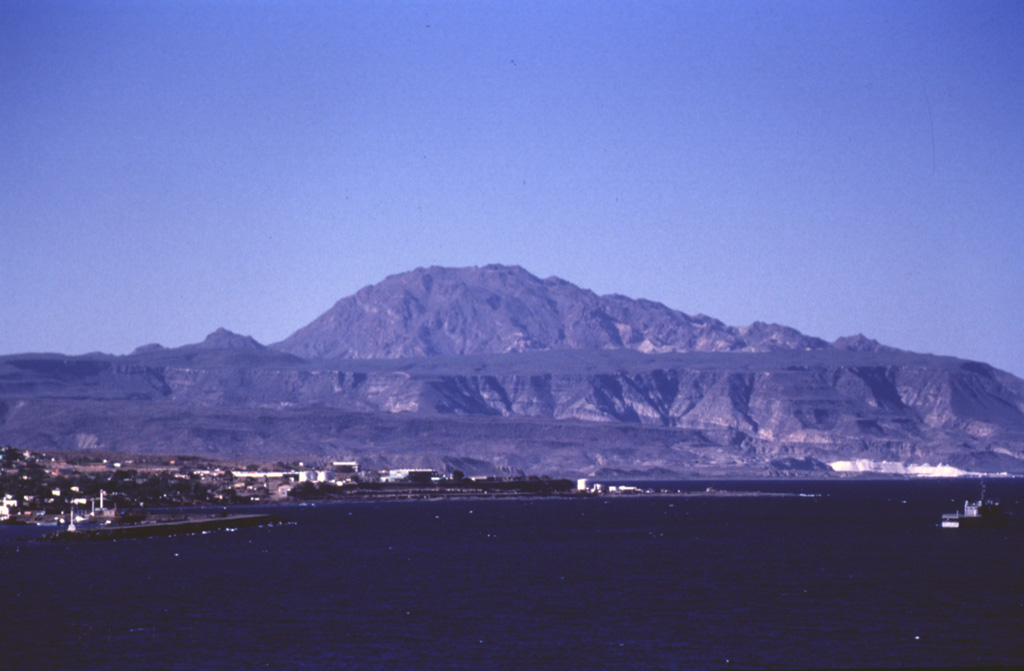
The Global Volcanism Program has no activity reports available for La Reforma.
The Global Volcanism Program has no Weekly Reports available for La Reforma.
The Global Volcanism Program has no Bulletin Reports available for La Reforma.
The Global Volcanism Program has no synonyms or subfeatures listed for La Reforma.
|
|
||||||||||||||||||
The Global Volcanism Program is not aware of any Holocene eruptions from La Reforma. If this volcano has had large eruptions (VEI >= 4) prior to 10,000 years ago, information might be found on the La Reforma page in the LaMEVE (Large Magnitude Explosive Volcanic Eruptions) database, a part of the Volcano Global Risk Identification and Analysis Project (VOGRIPA).
There is no Deformation History data available for La Reforma.
There is no Emissions History data available for La Reforma.
 The early Pleistocene La Reforma caldera lies NW of the town of Santa Rosita (left) on the Gulf of California. The roughly 10-km-wide caldera contains a central dome (center horizon) made of resurgent basement rocks. Ignimbrite outflow sheets form flat surfaces and scarps. The age of the caldera was determined by the K-Ar method to be between 1.6 and 1.4 Ma. The eruption of andesitic and dacitic ring-fracture lava domes followed. Andesitic lava flows were erupted on the flanks of the caldera both before and after caldera formation.
The early Pleistocene La Reforma caldera lies NW of the town of Santa Rosita (left) on the Gulf of California. The roughly 10-km-wide caldera contains a central dome (center horizon) made of resurgent basement rocks. Ignimbrite outflow sheets form flat surfaces and scarps. The age of the caldera was determined by the K-Ar method to be between 1.6 and 1.4 Ma. The eruption of andesitic and dacitic ring-fracture lava domes followed. Andesitic lava flows were erupted on the flanks of the caldera both before and after caldera formation.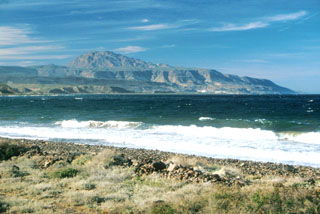 Post-caldera resurgent blocks of the early Pleistocene La Reforma caldera rise to the north above the Gulf of California. The roughly 10-km-wide caldera contains a 1300-m-high central dome (left-center horizon) made of resurgent basement rocks. Ignimbrite outflow sheets form flat surfaces and scarps, and uplifted marine terraces are prominent along the coast.
Post-caldera resurgent blocks of the early Pleistocene La Reforma caldera rise to the north above the Gulf of California. The roughly 10-km-wide caldera contains a 1300-m-high central dome (left-center horizon) made of resurgent basement rocks. Ignimbrite outflow sheets form flat surfaces and scarps, and uplifted marine terraces are prominent along the coast. 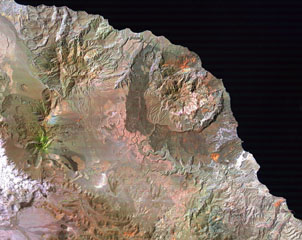 Three major Quaternary volcanic complexes are visible in this Landsat satellite image of Baja California. The N-S-trending Las Vírgenes volcanic complex to the left consists of three stratovolcanoes that are progressively younger towards the south. The 10-km-wide La Reforma caldera along the Gulf of California coast to the right displays darker andesite flanks and a resurgent dome in the center. The extensively eroded El Aguajito caldera has indistinct margins but the large resurgent dome forms the roughly circular eroded hills west of La Reforma.
Three major Quaternary volcanic complexes are visible in this Landsat satellite image of Baja California. The N-S-trending Las Vírgenes volcanic complex to the left consists of three stratovolcanoes that are progressively younger towards the south. The 10-km-wide La Reforma caldera along the Gulf of California coast to the right displays darker andesite flanks and a resurgent dome in the center. The extensively eroded El Aguajito caldera has indistinct margins but the large resurgent dome forms the roughly circular eroded hills west of La Reforma.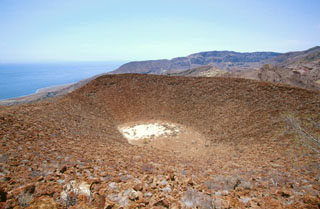 The summit crater of La Vírgen parasitic cinder cone on the east flank of La Reforma caldera is seen from its north rim. The SE rim of 10-km-wide La Reforma caldera forms the ridge on the horizon with the Gulf of California on the left.
The summit crater of La Vírgen parasitic cinder cone on the east flank of La Reforma caldera is seen from its north rim. The SE rim of 10-km-wide La Reforma caldera forms the ridge on the horizon with the Gulf of California on the left. 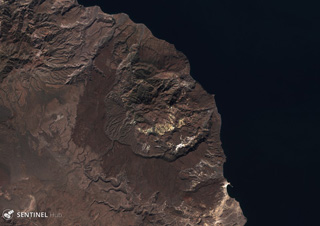 The early Pleistocene La Reforma caldera is in the center of this 16 November 2019 Sentinel-2 satellite image (N is at the top) along the Gulf of California. The caldera is about 9 km wide, with andesitic outer flanks and a resurgent dome in the center.
The early Pleistocene La Reforma caldera is in the center of this 16 November 2019 Sentinel-2 satellite image (N is at the top) along the Gulf of California. The caldera is about 9 km wide, with andesitic outer flanks and a resurgent dome in the center.Maps are not currently available due to technical issues.
The maps shown below have been scanned from the GVP map archives and include the volcano on this page. Clicking on the small images will load the full 300 dpi map. Very small-scale maps (such as world maps) are not included.
There are no samples for La Reforma in the Smithsonian's NMNH Department of Mineral Sciences Rock and Ore collection.
| Copernicus Browser | The Copernicus Browser replaced the Sentinel Hub Playground browser in 2023, to provide access to Earth observation archives from the Copernicus Data Space Ecosystem, the main distribution platform for data from the EU Copernicus missions. |
|
WOVOdat
Single Volcano View Temporal Evolution of Unrest Side by Side Volcanoes |
WOVOdat is a database of volcanic unrest; instrumentally and visually recorded changes in seismicity, ground deformation, gas emission, and other parameters from their normal baselines. It is sponsored by the World Organization of Volcano Observatories (WOVO) and presently hosted at the Earth Observatory of Singapore.
GVMID Data on Volcano Monitoring Infrastructure The Global Volcano Monitoring Infrastructure Database GVMID, is aimed at documenting and improving capabilities of volcano monitoring from the ground and space. GVMID should provide a snapshot and baseline view of the techniques and instrumentation that are in place at various volcanoes, which can be use by volcano observatories as reference to setup new monitoring system or improving networks at a specific volcano. These data will allow identification of what monitoring gaps exist, which can be then targeted by remote sensing infrastructure and future instrument deployments. |
| IRIS seismic stations/networks | Incorporated Research Institutions for Seismology (IRIS) Data Services map showing the location of seismic stations from all available networks (permanent or temporary) within a radius of 0.18° (about 20 km at mid-latitudes) from the given location of La Reforma. Users can customize a variety of filters and options in the left panel. Note that if there are no stations are known the map will default to show the entire world with a "No data matched request" error notice. |
| UNAVCO GPS/GNSS stations | Geodetic Data Services map from UNAVCO showing the location of GPS/GNSS stations from all available networks (permanent or temporary) within a radius of 20 km from the given location of La Reforma. Users can customize the data search based on station or network names, location, and time window. Requires Adobe Flash Player. |
| Large Eruptions of La Reforma | Information about large Quaternary eruptions (VEI >= 4) is cataloged in the Large Magnitude Explosive Volcanic Eruptions (LaMEVE) database of the Volcano Global Risk Identification and Analysis Project (VOGRIPA). |
| EarthChem | EarthChem develops and maintains databases, software, and services that support the preservation, discovery, access and analysis of geochemical data, and facilitate their integration with the broad array of other available earth science parameters. EarthChem is operated by a joint team of disciplinary scientists, data scientists, data managers and information technology developers who are part of the NSF-funded data facility Integrated Earth Data Applications (IEDA). IEDA is a collaborative effort of EarthChem and the Marine Geoscience Data System (MGDS). |